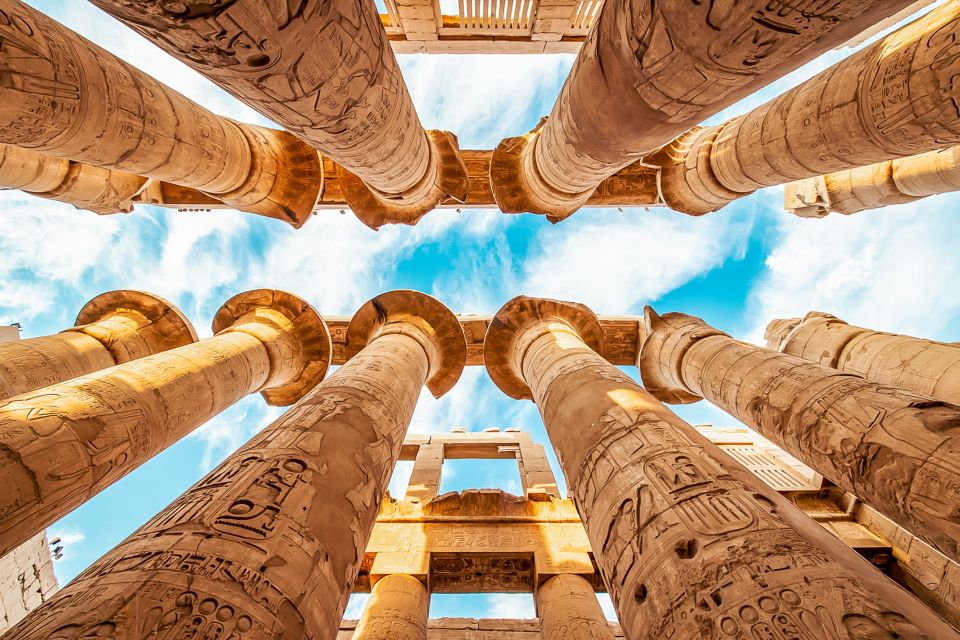Luxor
Explore the place

Discover the Wonders of Luxor: A Journey Through Ancient Egyptian History
Embark on an extraordinary journey to Luxor, the ancient capital of Egypt, often regarded as the world's largest open-air museum. Luxor, located in Upper Egypt, was the historical city of Thebes during the Middle and New Kingdoms. Known today for its majestic temples and the iconic Valley of the Kings, Luxor is a city steeped in unparalleled archaeological significance.
Situated on the Nile River, Luxor is home to approximately 1.3 million residents and houses some of the most significant discoveries from ancient Egypt. On the east bank lies the modern city, where the renowned Luxor Temple and Karnak Temple Complex can be found. Karnak is celebrated for its Hypostyle Hall, featuring 134 massive columns. The ancient city, known in Arabic as Al-Uqsur ("The Palaces"), was historically divided by a canal into two areas: the southern Luxor and the northern Karnak.
Today, while much of Thebes was destroyed in the Ptolemaic era, the remnants of its glorious past continue to attract visitors from around the world. This historic city offers a glimpse into the sophisticated civilization that thrived along the Nile, dating back to 3150 BCE when Upper and Lower Egypt were unified under the first pharaoh.
Here are some of the remarkable sites you can explore in Luxor:
1. Karnak Temple Complex
Karnak is a monumental ensemble of temples, chapels, and statues located in ancient Thebes. Dedicated to Amun-Ra, the supreme deity of Egyptian mythology, Karnak’s grandeur was designed to evoke awe and spiritual reverence. Visitors can marvel at the intricate artistry of the Hypostyle Hall and explore the vast courtyards, obelisks, and sanctuaries that showcase the architectural brilliance of ancient Egypt.
2. The Valley of the Kings (Biban El-Muluk)
This iconic valley is home to the tombs of pharaohs from the 18th, 19th, and 20th dynasties, spanning over 500 years of rule. Unlike earlier pharaohs who were buried in pyramids, the rulers of Thebes opted for hidden tombs carved into the rock to protect their treasures from looters. Some of Egypt’s most renowned pharaohs were laid to rest here, and the intricate craftsmanship of these tombs continues to captivate visitors.
3. The Temple of Hatshepsut (Deir el-Bahari)
Dedicated to Queen Pharaoh Hatshepsut, one of the few women to rule ancient Egypt, this mortuary temple is a testament to her legacy. Designed by her architect Senemut, the temple features terraced courtyards adorned with sculptures and intricate carvings. Despite damage caused by her stepson, who sought to erase her legacy, the temple remains an extraordinary tribute to her reign and devotion to Amun-Ra.
4. Optional Visit to Tutankhamun’s Tomb
Discovered in 1922 by Howard Carter, the tomb of Tutankhamun, or "King Tut," is one of the most significant archaeological finds of the modern era. Now, artifacts from his tomb, including his iconic 10-kilogram golden mask, have been meticulously reassembled and are displayed in the new Grand Egyptian Museum. This collection sheds light on the brief but impactful reign of the "boy king," who ruled during the 18th dynasty.
5. Optional Visit to the Tomb of Ramses VI
The tomb of Ramses VI, originally constructed for Ramses V and later expanded, is one of the largest in the Valley of the Kings. Its intricate carvings and detailed pharaonic cartouches illustrate the grandeur of Egyptian artistry. Despite centuries of looting and repurposing, the tomb remains a magnificent relic of Egypt’s past.
Many tombs in the Valley of the Kings have been plundered over time, yet they continue to hold incredible historical and cultural significance.
The RA Team is ready to guide you through the wonders of Luxor, offering an unforgettable journey into the heart of ancient Egypt!




